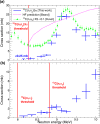Neutron-upscattering enhancement of the triple-alpha process
- PMID: 35444209
- PMCID: PMC9021293
- DOI: 10.1038/s41467-022-29848-7
Neutron-upscattering enhancement of the triple-alpha process
Abstract
The neutron inelastic scattering of carbon-12, populating the Hoyle state, is a reaction of interest for the triple-alpha process. The inverse process (neutron upscattering) can enhance the Hoyle state's decay rate to the bound states of 12C, effectively increasing the overall triple-alpha reaction rate. The cross section of this reaction is impossible to measure experimentally but has been determined here at astrophysically-relevant energies using detailed balance. Using a highly-collimated monoenergetic beam, here we measure neutrons incident on the Texas Active Target Time Projection Chamber (TexAT TPC) filled with CO2 gas, we measure the 3α-particles (arising from the decay of the Hoyle state following inelastic scattering) and a cross section is extracted. Here we show the neutron-upscattering enhancement is observed to be much smaller than previously expected. The importance of the neutron-upscattering enhancement may therefore not be significant aside from in very particular astrophysical sites (e.g. neutron star mergers).
© 2022. The Author(s).
Conflict of interest statement
The authors declare no competing interests.
Figures




References
-
- Freer M, Fynbo H. The Hoyle state in 12c. Prog. Part. Nucl. Phys. 2014;78:1–23. doi: 10.1016/j.ppnp.2014.06.001. - DOI
-
- Shaw PB, Clayton DD. Particle-induced electromagnetic de-excitation of nuclei in stellar matter. Phys. Rev. 1967;160:1193–1202. doi: 10.1103/PhysRev.160.1193. - DOI
-
- Meisel Z, et al. The Edwards accelerator laboratory at Ohio University. Phys. Procedia. 2017;90:448–454. doi: 10.1016/j.phpro.2017.09.050. - DOI
-
- Koshchiy E, et al. Texas active target (texat) detector for experiments with rare isotope beams. Nucl. Instrum. Methods Phys. Res. Sect. A: Accel. Spectrom. Detect. Assoc. Equip. 2020;957:163398. doi: 10.1016/j.nima.2020.163398. - DOI
Grants and funding
LinkOut - more resources
Full Text Sources

